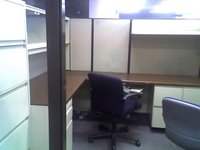The Usability of Office Cubicles

There is an interesting phenomenon that occurs in a corporate environment where occupants of a cubicle revert to pre-adolescently in regards to movement and sound. In this state the owner believes that since there are walls, parties on other sides of the walls cannot see nor hear the cubicle owner.
Cubicles give the owner the illusion of privacy, very much like good usability practices can give the illusion on speed and robustness where none exists. In application development if you include user prompts throughout the process the user remains informed, lessening the anxiety of not knowing what is going on. Using this illusion you “trick” the user into believing that a process is shorter than it actually is.
More recent academic studies have noted the disadvantages of the cubicle. While reducing the amount of noise and distractions in the office environment, the cubicle has reduced amount of person-to-person communication among office workers. While the removal of distraction is indicative of a straight through work process the lack of collaboration brings with it a stagnation of work processes. It is difficult to improve a process if there are no catalysts for improvement.
Cubicles have taken many shapes and sizes over the years and in many corporate environments the size and shape of a cubicle is directly related to your level in the organization with higher walls and even doors giving the illusion of an “office”. In some corporations cubicles that have collaborative team areas where there are no walls have been seen as a demotion for the occupants. In reality, these collaborative areas provide flexibility and a catalyst for creativity while providing an impromptu meeting space.


0 Comments:
Post a Comment
Subscribe to Post Comments [Atom]
<< Home